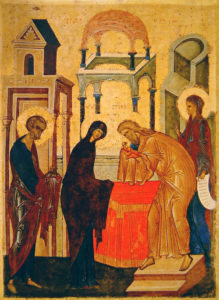Feast of The Purification of Mary and the Presentation of Our Lord
February 2
 The Lord be with you
The Lord be with you
Many people will be thinking of groundhogs today as they either rejoice or morn over whether or not Punxsutawney Phil sees, or does not see, his shadow. The celebration seems to date back to the 17th century in America and picked up speed in 1887 when the editor of the paper Punxsutawney Spirit began to promote their town’s groundhog as the official “Groundhog Day meteorologist.” Today it is basically just a day to have some fun. As Punxsutawney is about five hours away from us, I expect most of us will still have to rely on our local weather reporting for information about how long we will have to wait for warm weather.
On the liturgical calendar used at Our Redeemer (LCMS), today is recognized for something far more significant, the purification of Mary and the Presentation of Our Lord. Thirty-two days after Jesus’ circumcision and seventy weeks after the announcement of John’s birth to Zechariah by the angel Gabriel, the Lord comes to His temple to fulfill the Torah (Luke 2:22-38). The days are indeed fulfilled with the presentation. Jesus’ parents keep the Torah and fulfill it by bringing Jesus to His true home. Also, Jesus’ parents offer the alternative sacrifice of two turtledoves or two pigeons. Leviticus 12:8 allows this instead of a lamb, since not everyone could afford a lamb (showing the poverty and humility of Joseph and Mary). Yet no lamb was necessary because already here at forty days old, Jesus is the Lamb of God brought to His temple for sacrifice. Simeon’s Nunc Dimittis is a beautiful example of the immediate response to this inauguration of God’s consolation and redemption in the Christ Child:
“Lord, now you are letting your servant depart in peace,
according to your word;
for my eyes have seen your salvation
that you have prepared in the presence of all peoples,
a light for revelation to the Gentiles,
and for glory to your people Israel.” (Luke 2:29-32)
Simeon, representing the expectant nation of Israel, at last, after years of patient and faithful waiting, held the infant Savior in his arms. The consolation of the nations, the light to the Gentiles, had come. The child was being presented to God by his parents, but in this child God was coming to meet his people, so that he who is the light of the world might make his people lamps shining in a dark world that others might see the right path. Simeon’s song has been sung by countless generations of believers ever since.
But Scripture does not stop with simply a heartwarming story. The Light casts a shadow. Simeon spoke of this as well. Speaking to Mary, Simeon also prophesies about the destiny of the child:
“And Simeon blessed them and said to Mary his mother, ‘Behold, this child is appointed for the fall and rising of many in Israel, and for a sign that is opposed (and a sword will pierce through your own soul also), so that thoughts from many hearts may be revealed.’” (Luke 2:34-35)
The long awaited Messiah will achieve no easy triumph. He will be the center of storm and controversy that will reveal the secret disposition of many hearts and will bring piercing grief to his own mother. The Messiah, who comes to lead Israel to glory, must go by the path of suffering, and his people must go with him along that same path.
For those who like history about Feasts:
This Feast has been on every liturgical calendar in every major English hymnal issued by the LC-MS. The name has changed a bit, however. In our first English hymnal (The Evangelical Lutheran Hymn-Book) it was simply named “The Presentation of Christ.” With our second English hymnal (The Lutheran Hymnal) the name was expanded to “The Presentation of Our Lord and the Purification of Mary.” In Lutheran Worship the name was shortened again to “The Presentation of our Lord.” Finally, in our current hymnal (Lutheran Service Book), the name given is “The Purification of Mary and the Presentation of Our Lord.” I’m not so sure I like Mary getting “top billing.” Maybe when we get another hymnal (after I retire) the name will be modified yet again.
This Feast originated in the Eastern Churches. The day was observed in Jerusalem at the end of the fourth century and was introduced in Constantinople by the Emperor Justinian in 542. In the West, the day seems first to appear in the sacramentaries of Gelasius (seventh century) and of Gregory (eighth century). Pope Sergius (d. 701) seems to have introduced the practice of a procession with lighted candles on this date, probably reflecting the “light” spoken of by Simeon.
Prayer: Almighty and ever-living God, as Your only-begotten Son was this day presented in the temple in the substance of our flesh, grant that we may be presented to You with pure and clean hearts; through Jesus Christ, our Lord, who lives and reigns with You and the Holy Spirit, one God, now and forever. Amen.
Other topics this Feast might inspire you to pray about:
• For the illumination of the darkness of the world
• For the aged
• For those who wait patiently for salvation
• For those who have become mothers
• For newborns
Blessings in Christ,
Pastor John Rickert
If you like this post, why not share it?
